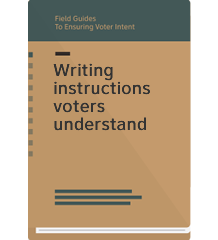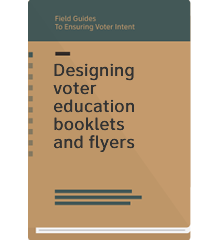Plain language
Plain language (also called plain writing or plain English) is a writing and communication method. The goal is that readers can:
- Find what they need
- Understand what they find
- Use the information
Writing in plain language helps you clearly communicate complicated ideas to a wide audience. When it comes to voting, plain language helps voters vote the way they intend and fill out forms correctly the first time. It also helps to cut down on questions and errors, which in turn frees up time for election administrators to focus on other necessary tasks.
Who is plain language for?
Everyone! Almost 1/2 of adult Americans struggle to read. Cognitive or vision issues and low education levels contribute this. But being rushed or stressed can also negatively impact your reading comprehension.
Writing in plain language in English also makes translations into other languages easier to understand.
How do I write in plain language?
Writing in plain language is a process. Build in time to edit what you write, and show it to other people to get their reactions. Consider doing usability testing on your everything you write.
A few strategies to use when writing in plain language:
- Write for your audience. Use words that they use instead of legalese.
- Use simple words. Short and common words are often best.
- Use simple sentences. 1 idea per sentence. Use bullet points for lists, and numbered lists for steps.
- Use positive language. Say what someone should do instead of what not to do.
- Use words consistently. If there are many ways to say something, pick 1 option and stick with it.
- Use active voice. Active voice uses the standard word order in English.
- Say “if” before “then”. This helps readers quickly know if the
- Speak directly to the reader. Use personal pronouns like “you” and “we.”
Getting started
Tools
In addition to the CCD tools listed above, also check out:
- Hemingway Editor – A free online tool that highlights many plain language criteria such as excess words, passive voice, hard to read sentences, and phrases with simpler alternatives. It color codes problem areas and gives a readability score.
- PlainLanguage.gov – A website with lots of plain language guidance, examples, and resources. It is run by the Plain Language Action and Information Network (PLAIN), an unfunded working group of federal employees from different agencies and specialties who support the use of clear communication in government writing.
Articles
- Excerpt from the book Writing for Dollars, Writing to Please by Joseph Kimble (2023)
- Writing election information that everyone can read – Characteristics of low literacy voters and broad principles to improve your materials
- Less can be more in official notices – 3 principles to keep in mind when writing official notices
- Election vocabulary voters don’t get — and what to do about it – A list of quick swaps to make when writing election materials
- If a legal right is not readable, is it really a right? – Making legal language understandable
- Ballot questions are hard to understand. Here are 6 ways to fix them. – Common problems with ballot questions and how to fix them
- How can we make requirements clear? – Why we recommend using “must” instead of “shall”
Projects
Research
The report includes a complete step-by-step guide on how to improve your state’s voter signature form, as well as a more detailed dive into other strategies that can be deployed to improve readability and simplify content in vote-by-mail envelope design.
- Related Article: 3 strategies to improve vote-by-mail signature forms
Report: Explaining ballot questions in plain language
When it comes to ballot questions, context is important. Voters bring different understandings of the questions—and different levels of civic literacy when they start to mark their ballot. This report, written for Clarity Journal, shares findings from CCD’s work in 2022 with the League of Women Voters of California.





